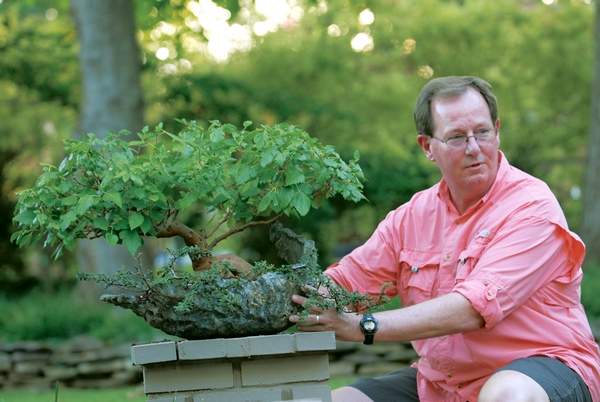
Love at first sight is the best way to describe Dan O’Neal’s attraction to bonsai trees.
O’Neal, senior development officer in the office of Institutional Advancement at Converse College, bought his first bonsai plant on his honeymoon 35 years ago in Hilton Head.
Since that time, he has studied under bonsai masters and worked countless hours watering, pruning and shaping the trees into works of art. His background as a wildlife biologist helps, but he still needed classes and training with experts.
“I bought my first bonsai tree because I thought it was nice,” he said. “These trees mimic nature. You can take a young tree and make it look old.”
O’Neal said bonsai is a combination of art and horticulture, meaning an intense knowledge of plants and an artistic eye are needed.
There are more than 35 species and a total of 85 trees in his backyard on the east side of Spartanburg. Each tree is in a different phase of refinement or development. O’Neal spends about two hours a day caring for his collection. The trees are watered twice a day and pruned once a day.
“I didn’t have a clue what I was getting into when I bought my first bonsai tree, and I am still learning,” he said. “You are never finished with bonsai trees because they are constantly growing. The only bonsai you are finished with is a dead one.”
Bonsai is a tree in a pot usually grown in soil composed of rock. It is a practice dating back thousands of years ago in China and Japan. The hobby was passed down for generations, and now people all over the world are avid bonsai artists.
“Bonsai is horticulture raised to the level of art,” said Randy Clark, owner of the Bonsai Learning Center in Charlotte, N.C. “The public thinks bonsai is some mystical, ancient art you have to study for 30 years, but it isn’t. There are no ancient secrets. If you can grow a zucchini, you can grow a bonsai plant.”
Clark became interested in bonsai plants more than 30 years ago while living in Minneapolis. He moved to Charlotte and opened the learning center in 1995. Over the years, O’Neal has taken many classes with Clark.
“You have the painters and the art collectors in bonsai,” Clark said. “Dan and I are the painters. It is nice to have a finished tree, but it is the trip going there and watching it grow and develop that is important to us.”
Clark describes his love for making bonsai trees as a hobby that got out of hand. He said once a person becomes interested in making the trees, it becomes addictive. O’Neal agrees it is habit forming.
“I got very serious about it 20 years ago,” O’Neal said. “I started with junk trees because you don’t want to spend a lot of money and kill the tree. It takes training and practice to really know what you are doing.”
His collection contains a 400 year-old Ponderosa pine from Wyoming, a Kingsville boxwood more than 50 years old from a monastery in Georgia, and a bald cypress grown in the swamps of South Carolina. He recently received the National Award of Merit for a Satsuki azalea, an 85-year-old plant from Japan, at the Bonsai Invitational in Charlotte.
That award was earned through a great deal of hard work and commitment. Every morning and afternoon, O’Neal waters the trees. Each species requires a different amount, and he knows almost everything there is to know about them. The pruning work is usually done in the afternoon when he has more time. He takes out a satchel of tools resembling the sharp instruments surgeons use and begins working.
To shape and design the tree the way he wants, O’Neal twists copper wire around each branch. The limbs can stay wired from six months to three years. The wiring is taken off and replaced regularly during that time. It is a tedious process, but the benefits are tremendous when he gets a tree just right.
Trips out of town sometimes require O’Neal getting help from his wife, Lynn, or a trusted friend to water the trees. The special care and attention waits until he returns home.
During the winter months, the trees go into a dormant phase and require little work. The tiny trees mimic the large ones going through all four seasons and developing colorful leaves during the fall.
“I am just the caretaker of the trees for my lifetime,” O’Neal said. “Some of them will probably go into a national museum.”
Talking about bonsai trees can sometimes become philosophical because O’Neal said he has learned life lessons from them.
“Through stress you grow stronger, and that is what you do with the limbs of a bonsai tree,” he said. “When I think about all of the work and effort that goes into them, I think about how all efforts of worth and excellence are difficult. The best things in life are the ones you have to work for.”
Bonsai trees can live a long time with the proper care, but that isn’t what happened to the one O’Neal bought on his honeymoon years ago. The only thing left is the small dead trunk.
“Since the tree died, my wife asked me what does that mean for our marriage,” he said. ”I told her trees can be replaced, but she can’t.”
Source: www.goupstate.com




